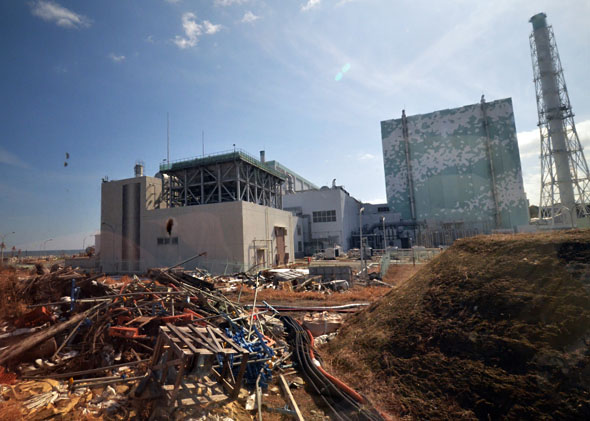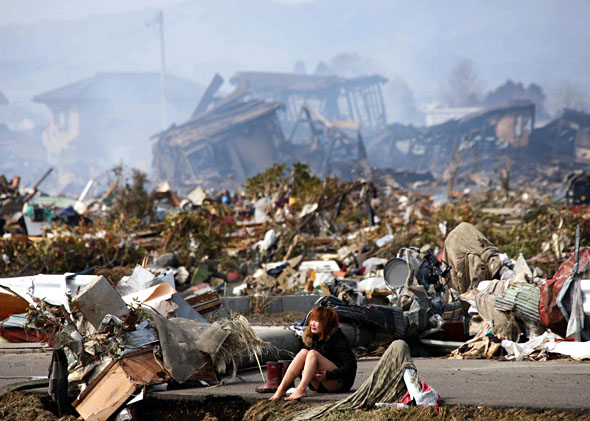
Photo by Yoshikazu Tsuno/AFP/Getty Images
On a heavily guarded campus east of San Francisco stands Lawrence Livermore National Laboratory, one of the U.S. government’s premier scientific research facilities. Hours after a massive earthquake and tsunami struck Japan on March 11, 2011, a team of Livermore scientists mobilized to begin assessing the danger from the crippled Fukushima Dai-ichi nuclear plant. The 40-odd team members include physicists, meteorologists, computer modelers, and health specialists. Their specialty is major airborne hazardsâ€"toxic matter from chemical fires, ash from erupting volcanoes, or radioactive emissions.
The scientists’ workâ€"secret at the time and barely known to the public even todayâ€"had an enormous impact on Japan’s nuclear crisis, averting a potentially disastrous U.S. overreaction. This tale reveals significant new information about the accident's severity and affords a different perspective on events at Fukushima, which have generally been portrayed as a near Armageddon.
News reports fueled the widespread view among the general public that much of eastern Japanâ€"including Tokyo, about 150 miles southwest of Fukushimaâ€"would be badly contaminated if the struggle to contain the radiation leaks failed. Tokyo’s airports were mobbed with fleeing foreigners. Senior commanders of U.S. forces in Japan were privately fearful about the risks to American military members and their families at the U.S. bases in the Tokyo area. High-ranking officers were arguing that radiation might well require a mass evacuation.

Photo by Asahi Shimbun/Reuters
President Obama's top science advisers turned to Livermore to determine the extent of the peril to the Japanese archipelago. After days of high-intensity analysis and numerous computer runs, the scientists concluded that radiation in Tokyo would come nowhere close to levels requiring an evacuation, even in the event that Fukushima Dai-ichi underwent the worst plausible meltdown combined with extremely unfavorable wind and weather patterns. Obama was briefed on the findings, and pressure for an evacuation abated.
Key details of this episode are revealed here for the first time, based in part on U.S. government documents released under the Freedom of Information Act. These revelations, together with additional new information, debunk some powerful myths about Fukushima and have weighty implications for the debate about nuclear power that has raged in the accident's aftermath. (The revelations are unrelated to the plant’s current water-leakage problem, which by some reckonings is less severe and more solvable than recent headlines suggest.)
What was Fukushima's worst-case scenario? That question consumed the thoughts of millions of people in March 2011, and it remains highly relevant today. One of the most compelling arguments advanced by opponents of nuclear power is that Tokyo only narrowly escaped harmful radiation, and if the accident had spun further out of control and winds had shifted, contamination in the metropolitan area would have been serious enough to warrant the urgent departure of its 30 million residents. Worse yet, the Japanese government supposedly knew all along, from a scenario its own experts had developed, that Tokyo was in grave danger. Naoto Kan, who was prime minister at the time and has since become a leading advocate of eliminating nuclear power, draws headlines with his estimate that the evacuation of 50 million Japaneseâ€"with ensuing “mass panic†and “many casualtiesâ€â€"came terrifyingly close to reality.
As someone who spent 27 years at major newspapers, I can easily understand why the media jumped on stories about the apocalypse that supposedly menaced Tokyo. Such stories conjure up images worthy of a Godzilla filmâ€"people thronging trains and highways to flee the world's largest metropolitan areaâ€"ideal for boggling the minds of readers and viewers.

Photo by Issei Kato/Reuters
The accident was the worst involving radioactivity since the 1986 explosion at Chernobyl, and it forced tens of thousands of people living near the plant from their homes. And the release of radiation could have been even worse.
But the claims about the potential for an evacuation of Tokyo have grievously misinformed the public. The Livermore scientists’ worst-case scenario shows the threat was overblown. Furthermore, close scrutiny of U.S. documentary evidence undermines another popular perception. Japanese officials have been portrayed as misleading the public with soothing pronouncements and U.S. officials as telling the unvarnished truth. This depiction has had a major effect on public attitudes toward official assurances about the safety of food, water supplies, and living conditions in the eastern part of Japan. But as a related story shows, the unfavorable impression of Japanese officials' candor comes in part from a grossly incorrect statement by an American nuclear official.
The true story of what happened at Fukushima is not exactly suitable for a horror movie, but it is mind-boggling in its own way.

Photo by Kenji Chiga/Washington Post/Getty Images
It was the second explosion in a Fukushima Dai-ichi reactor building, and then a third, that galvanized U.S. officials into action. "I worry that we may be undershooting here" about the possible spread of radiation, said Stephen Trautman, deputy director of the Naval Reactors Program, in a March 16, 2011, conference call with other U.S. nuclear experts, according to a transcript of the conversation. "And the whole issue that we're trying to get to is, if this thing goes down badly in the near future, there's a lot of American citizens ... that we're going to have to deal with and give advice to."
The main focus of concern was the 40,000-plus active-duty military members, Defense Department civilians, and family members at the Yokosuka Naval Base, Atsugi Naval Air Station, and the Yokota Air Base, all of which are near Tokyo. Those bases are key to the U.S. strategy of maintaining stability in the Asia Pacific. The admirals and generals who command those bases are keenly mindful of the geopolitical imperatives but also place high priority on "force protection." Military families, aware of the flight by civilian foreigners from Tokyo, were clamoring for action, and Adm. Robert Willard, commander of U.S. forces in the Pacific, took the lead in championing their cause.

Photo courtesy of Staff Sgt. Samuel Morse/Air Force
Backing him up were projections from Bettis Atomic Power Laboratory, a Pittsburgh-based facility that designs and develops nuclear-fueled equipment for the Navy. A memo dated one week after the earthquake cited the lab’s models showing that radiation substantially exceeding U.S. government standards was likely to reach Yokosukaâ€"which is even farther from the crippled plant than Tokyo isâ€"if the reactors and nearby pools of spent fuel were not stabilized. “Navy civilians, military personnel, and their dependents should depart within the next few days ... prior to exceeding the general public exposure limit,†the memo said, concluding ominously: “In the more extreme scenarios involving significant core or pool damage, there would not be sufficient time to evacuate Navy civilians, military personnel, and their dependents to avoid the higher exposure levels discussed above.â€
In the White House Situation Room, an emergency task force included officials from so many agencies that the screen showing video-conference participants was often divided into 32, with people from the Pentagon, Hawaii, Tokyo, and elsewhere. The diplomats involved resisted troop evacuations: What kind of signal would that send to China, North Korea, and allies around the world? If panic erupted in Tokyo, wouldn't that irreparably harm the U.S.-Japan relationship?
The administration was bound by exposure-level standards set by the Environmental Protection Agency. Those standards don't translate into "danger" in the commonly used sense of the word; exposure at such low levels doesn't make people sick or render them more likely to get cancer someday. There's a slightly higher risk of fatal cancerâ€"an additional 0.5 percentâ€"for those who receive a cumulative lifetime dose of 100 millisieverts (a measure of radiation’s effect on the body). The EPA standards set trigger points for protecting the general public well below that level, at a dose low enough that the risk of additional cancers is undetectable.
Washington authorized "voluntary departures,†including government-paid flights, for dependents of military and diplomatic personnel. But if radiation levels in the Tokyo region were about to breach EPA standards, the White House would have little choice but to order a mass evacuation. The overarching question was whether radiation levels were really headed above the standards, as the Navy was insisting with ever-greater intensity.
No comments:
Post a Comment